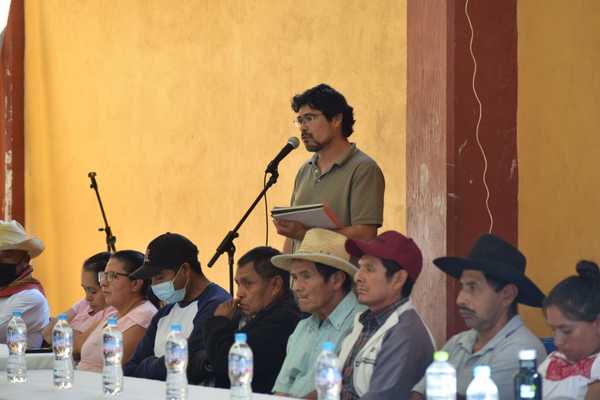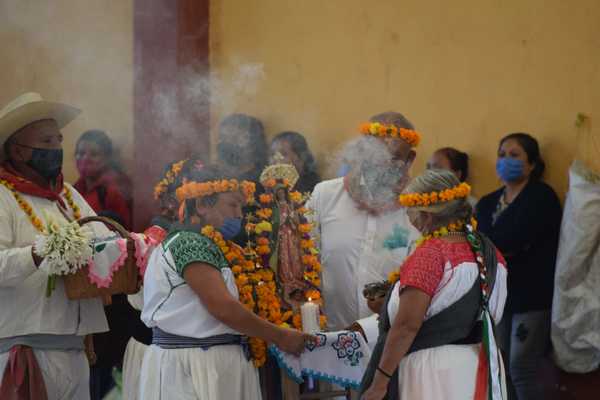Historical and anthropological research often serves academic objectives and concerns but does not nurture the transformations that communities seek in their urgent resistance struggles. Those who contribute locally to such research are “marginalised”, as mere “informants.” The real and complex history of the people living in such regions frequently gets erased because outsiders decide the focus.
In contrast, when working on a participatory research process civil society organisations, movements, and communities make efforts to shape a collective, historic and current diagnosis of the conditions weighing on a particular region, and if possible, their more holistic, geopolitical implications. Moreover, these research processes build bridges with other movements struggling in other regions for the same reasons, connecting and uncovering corporate and government plans and investments and their nuances.
This document on Territories of Water, tells the story of communities in the Puebla-Hidalgo Sierra that defend their water commons (against the Tuxpan-Tula gas pipeline). We stress the fact that it was built through participation as a multi-layered research piece. Its intention is to return its findings to the communities from which these voices emerged to serve as a transformation tool. Bringing together the scattered fragments and details of the various circumstances involved, was a collective work for reconstituting the role of the communities and persons who live in this intersection of the sierras between Puebla and Hidalgo in North-eastern Mexico.
 Itzam Pineda from UACMilpa closing the presentation with the conclusions. At the table several members of the Consejo Regional de Pueblos Originarios en Defensa de los Territorios de Puebla-Hidalgo (Regional Council of Indigenous Peoples in Defence of the Territories of Puebla-Hidalgo). Photo: Clarissa Torresblanca
Itzam Pineda from UACMilpa closing the presentation with the conclusions. At the table several members of the Consejo Regional de Pueblos Originarios en Defensa de los Territorios de Puebla-Hidalgo (Regional Council of Indigenous Peoples in Defence of the Territories of Puebla-Hidalgo). Photo: Clarissa Torresblanca The document reflects the process of deep reflection (legal, historical, anthropological, and about what it means to live in these spurs). It reflects the resistance to the threat that looms over this corner of the world: the Tuxpan-Tula gas pipeline and the company that has been trying to activate it for at least six years, TransCanada, now transformed into TC-Energy. This is a company that has a string of irregularities against Otomi, Nahua, Tepehua and Totonaca communities in Mexico, and against Wet'suwet'en communities in the Canadian Pacific.[1]
Since the end of 2017, Otomi, Nahua, and Tepehua communities in the Sierra region known as Puebla-Hidalgo had already gathered in local indigenous councils and then in the Consejo Regional de Pueblos Originarios en Defensa del Territorio de Puebla e Hidalgo [Regional Council of Indigenous Peoples in Defence of the Territory of Puebla and Hidalgo]. The latter is the result of a grassroots network of villages, localities, communities, and ejidos that, knowing they will be affected by the gas pipeline, began to organise their understanding of the damage that the crossing of the gas pipeline will cause. The above led them to undertake a series of legal actions to stop the pipeline and the company's schemes. At least three of these defensive legal actions (writs of amparo) have been won and still stand.
In these organisational and legal actions — and in the face of absurd legal doubts that there were indigenous peoples in the area — a group of researchers, all activists, professors at the Universidad Autónoma de la Ciudad de México (UACM), at the Instituto Nacional de Antropología e Historia, and researchers from the Centro de Estudios para el Cambio en el Campo Mexicano (Ceccam), the Universidad Nacional Autónoma (UNAM) and GRAIN undertook a participatory and collaborative exercise talking with the communities and listening to their testimonies, reflections, and stories, weaving their history with their current views of what the pipeline means to them.
It would have been challenging to conduct research with all the locations through which the pipeline will cross. The pipeline is a private line, 36 inches in diameter, aiming to transport 886 million cubic feet per day of natural gas from Texas in the United States along 263 kilometres. Although its useful life will be 25 to 30 years, it will affect at least 260,000 people from 459 localities in 34 municipalities in Veracruz, Puebla, Hidalgo, and the State of Mexico.
This portrait was woven with communities considered to be directly affected, which undeniably maintain an active, living relationship with the rest of the localities that will be affected, including 444 communities that the government excluded from any legal consideration. Nonetheless, the regional portrait acquires spatial volume, geographical configuration, and a long and short-term historic background, with panoramic regional scope and many local details from various corners of that territory.
This type of research, approached from below, systematises and assembles the apparently scattered fragments of what Chila, San Pablito Pahuatlán, San Nicolás Tolentino, Montellano, Ahuacatitla, Cuautepec, San Antonio el Grande, San Andrés, but also Zoyatla, Aguacatitla, Tlacuilotepec, Honey, Cuauneutla, Cruzanta, Tlacruz, and other communities managed to express: stories, experiences, testimonies, collective memory, organisational understanding, legal and political vision, and something that escapes many “social” or political investigations: the relationship with “the sacred”, the ontological basis that reveals deep, centuries-old bonds.
 Blessing of the image of the Virgin of Guadalupe (Tonantzin), presiding over the ceremony. Photo: Clarissa Torresblanca
Blessing of the image of the Virgin of Guadalupe (Tonantzin), presiding over the ceremony. Photo: Clarissa Torresblanca The document begins by explaining the current situation. It updates the resistance of the communities embodied by the Regional Council, and the government's actions and its evasion of responsibility. It also describes the devastation and dispossession the gas pipeline will bring to the region.
This is followed by a short but documented profile of TransCanada, today TC-Energy, and its ways of doing business, in Mexico and other countries.
The affected area is shown in maps with some detail. We attempted to characterise the specific repercussions of the pipeline, and the industrial networks and corridors to which it is linked. From these threads emerged a continental relation (through North America) with many links flowing from the United States' bowels arriving from Texas to the town of Tuxpan in Mexico on its way to Tula, and from there to the country's Western end. From there the thread climbs North weaving pipelines and connections with the Northwest of Mexico and the Southwest of the United States, where it can return to Canada, activating the integrative forecasts of the USMCA agreement.
Another section of the document draws heavily on the testimonies of the people from the communities. It gathers and systematises the common notion and meaning of water for the people who inhabit the Puebla-Hidalgo ravines. Their voices shed light on their understanding of this universe of springs, aquifers, streams, wells, rivers and torrents, waterfalls, and wetlands that configure the impressive cloud forest: this ecosystem with water at its heart, and its communal but also sacred dimensions.
The regional history illuminates the wandering of people and their communities, the invasions, the region as a path or “crossing” between the centre and the North-eastern coast of Mexico. We tracked down the agrarian configuration of the Sierra throughout history and the compelling conviviality of such peoples as the Ñuhú (the Otomí of the north), the Nahua, the Tepehua, and the Totonacos, in a multilingual environment that does not prevent them from living together in mutual understanding.
There is a strong presence of their ritual spheres, their local particularities, and their own stories, the perceptions of what each community is and how it contributes to the fabric of these “water territories.” The portrait reveals a centuries-old continuity that is receiving the massive impact of multidimensional dispossession: an invasion of the pipeline, a process of water and land grabbing, fragmentation, corruption and the eviction of communities, pollution, and devastation.
The document says: “The project of Capital urgently needs to break up people's relationship with the land, with nature, with the environment, with their territory: it seeks to damage the means that bind this relation by eroding, undermining and even banning all knowledge through which people relate to nature: knowledge that has been at the service of their subsistence for hundreds of years.”
This leaves communities “fragile in the face of the demands of corporations, companies, and governments that invade, impose, subdue, disrupt, fragment and rearrange the vital space in which conviviality prevailed.”
“Tearing away the decisions about territory and water commons from the communities in order to subsume them to market logic, disarticulates all other ways of conceiving their milieu and its relation with the world: their forms of organisation, language, narrative, ritual, and cosmology. Also, knowledge and strategies of subsistence, life itself, their longstanding relationship with nature, all the fabric that has made humanity diverse since its origins, that has allowed communities to survive in their care for their surroundings.”
The document concludes: “The Puebla-Hidalgo Sierra is currently hosting a fundamental piece to understand why people struggle for autonomy, which is not a new struggle. Since time immemorial, different peoples and their communities, have sought to not be subjected to the designs of others. Instead, they seek to walk their own path, solve what matters most to them through their own creative means, coexist with whoever seems best to them, and propose their own ways of being and staying in the world. In this struggle, in this dialectic between imposition and resistance in search of autonomy, their struggle dates back to before the Spanish invasion, continued through the wars and political games of the Independence movement where liberals and conservatives sought power. This struggle goes on in contemporary Mexico, a country that emerged from a revolution and recovered the memory of many communities, of everything that continues to be the fabric of what they claim: to remain, to continue being, to continue understanding who they are, what they live for, and why it is worth fighting for”.
On December 6th, 2021, the whole team that worked with these various communities, presented the results of more than four years of community and desk collective work to the Regional Council. In the end, this research is theirs, it is a gift these communities have given us and we hope the whole document can become a living tool for conviviality, resistance, and transformation. The presentation of the document took place in Chila, a highland community that has vowed to resist the gas pipeline. The people from the Regional Council accepted and celebrated the document, and have committed themselves to continue their struggle, eventually establishing links with the Wet'suwet'en communities that resist TC-Energy in Canada. This is not the end; it is a beginning.[2]
[1] Just last mid-November, TC-Energy-owned Coastal Gaslink activated the Canadian government's repression against members of the Gidimt'en clan when they attempted to stop them from entering the Wet'suwet'en territory. Sleydo', the spokesperson for the Gidimt'en clan, commented on the eviction enforcement, “The Wet'suwet'en hereditary chiefs have never ceded, surrendered or lost title to this territory through war. That means that what they say must be done. According to the eviction order of January 4, 2020 GLC has to withdraw from the territory and not return. They have been violating this law for far too long now.”. The so-called Canadian Mounted Police responded and arrested 29 people. The Wet'suwet'en authorities demanded their immediate release. See https://forms.gle/hwn8T7YC75DwLh9X7
https://awasqa.org/es/2021/11/15/gidimten-desaloja-a-coastal-gaslink-del-territorio-wetsuweten/#pll_switcher. See also https://www.cbc.ca/news/canada/british-columbia/rcmp-wet-suwet-en-pipeline-resistance-1.6254245
[2] Listen to Radio Expresión: “Presentan libro sobre defensa del territorio contra gasoducto Tuxpan-Tula, podcast narrated by Heriberto Hernández. https://open.spotify.com/episode/5l9xUoZZ5aMvV1dQWvu3oc?si=c34d679433024262